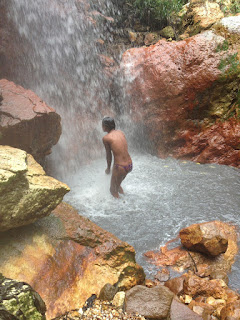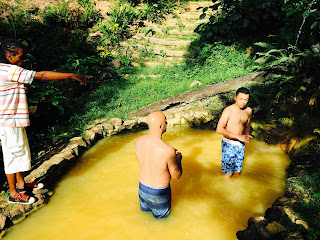The Copper Pool
The Wondrous Benefits of Mineral Springs
Who would not enjoy a nice, relaxing day at a hot spring to soak those aches away and alleviate the stresses of the day? The answer, surprisingly, is a lot of people. Some people think the water will cause third degree burns or lava will spew forth and kill them while they are bathing in the waters. Fortunately, this is far from reality. Indeed, natural hot springs offer a wide range of benefits and therapy’s. When in their natural state, they provide great aesthetic beauty and also
provide science with a rare view into the life of early microbial life forms.
provide science with a rare view into the life of early microbial life forms.
Balneotherapy (from Latin: balneum, "bath") is the treatment of disease by bathing, usually practiced at spas. The benefit of bathing in natural warm springs is that high temperature water contains more dissolved solid minerals. Because of this, many
mineral water spas are rich in particular minerals such as silica, sulfur, selenium, calcium, lithium, and radium which can be absorbed through the skin. In addition, certain warm springs provide the materials to produce high quality medicinal clays that are widely used to treat muscle aches or joint pains, clear up skin ailments, and detoxify the body. The practice of using special clays is known as "fangotherapy."
mineral water spas are rich in particular minerals such as silica, sulfur, selenium, calcium, lithium, and radium which can be absorbed through the skin. In addition, certain warm springs provide the materials to produce high quality medicinal clays that are widely used to treat muscle aches or joint pains, clear up skin ailments, and detoxify the body. The practice of using special clays is known as "fangotherapy."
Sulfur is a mineral naturally occurring near hot springs and volcanic craters. The "rotten egg" smell of sulfur mineral baths is caused by sulfur dioxide gas escaping into the air. Sulfur has been used medicinally since ancient times, and it is contained in every cell in the body. It is comprised of three different amino acids (the building blocks that make up protein). Approximately 0.25 percent of your total body weight is sulfur. It is most concentrated in keratin, which gives you strong hair, nails, and skin. It is known as "nature's beauty mineral" because your body needs it to manufacture collagen, which keeps your skin elastic and young-looking.
Developed Natural Warm Springs
While these amazing creations have been around for eons, warm springs have only been a source of revenue for roughly one hundred years. Many states in the US have areas containing warm springs to include New Mexico, Colorado, California, and even Alaska. Entrepreneurs purchase land plots and develop the areas into resorts. Cement pools are built to contain the water and the surroundings are nicely landscaped. Multitudes flock to spas hoping to enjoy the numerous health benefits without worrying about the water being too hot or unsafe. Commercial and private hot springs are found throughout the world.
Dangers and Fears of Natural Warm Springs
In general, when you ask people about warm springs and mineral springs, most respond that they are worried about the water burning them alive or the lava bursting from the ground or poisonous gases killing them. In actuality, natural hot springs do not have any lava and are instead heated by the hot rocks in the Earth’s mantle. According to Ward Cameron, “A mineral spring is defined as one that contains a reading of 400 parts/million of total dissolved solids. In the case of the thermal springs in the Rockies, their formation tends to be quite consistent. As rain falls on the surrounding peaks, it percolated into the rather porous sedimentary rocks. As it descends through the rock, it picks up a variety of materials, everything from radium to sulphur. Also, as it moves further beneath the surface, it heats up from the primal heat of the Earth. Eventually, it encounters a large thrust fault, or crack. As water descends behind it, it forces the now heated water to ascend along the fault-line to surface as a hot or warm spring. Also critical in the creation of a hot spring, is an express route to the surface. If the water moves slowly from depth to the surface, it will cool back down before it bubbles out as a spring. Luckily, since many of these springs occur in limestone formations, the openings allowing the water to the surface may be enlarged by dissolving of the limestone to create a virtual pipeline to the surface. This assures a quick trip and warm waters”.
Warm Springs are natural phenomena found on all continents and most countries around the world. Throughout the centuries, people have enjoyed these natural wonders for their scenic beauty, scientific value and mysterious natural healing powers. The rich colors of these formations draw people to simply admire their natural beauty. Scientists are attracted to these sites so they may investigate early bacterial life forms detected in the pools. Many sufferers of such ailments as psoriasis, eczema, dandruff, warts, arthritis, shingles and muscle aches are willing to disregard any potential dangers or ignore their fears to reap the benefits of the warm, therapeutic waters. These people are also willing to pay the price at private and commercial resorts. Although there are some potential risks associated with hot springs, the numerous benefits offset these concerns.












No comments:
Post a Comment